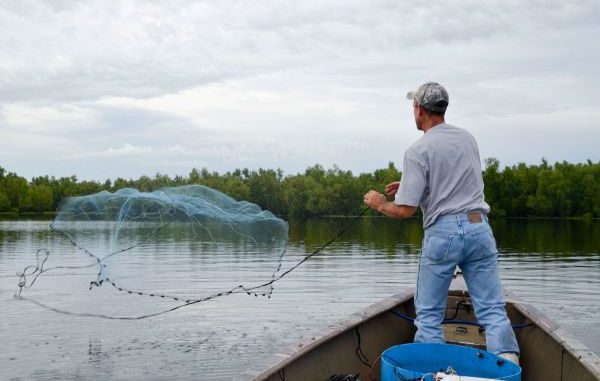
“It’s harder to catch the bait than it is to catch the fish,” Johnny Broussard said, with note of frustration in his voice. “I spend a lot of time getting bait.”
Bait for Broussard means shad 90 percent of the time. He sometimes uses bream that he catches with a cast net from a friend’s private pond, but any bream taken with a cast net from public waters must be immediately released.
Bream are game fish, and as game fish may only be taken by legal game-fishing methods, which means hook and line. Once legally caught, however, they may be used as the fisherman sees fit; they may be eaten or used as bait.
Broussard likes 4- to 6-inch-long shad.
“The bigger the shad are, the longer they will stay alive (in a bait barrel), he explained. “I’ve caught catfish with 12-inch shad, although shad that big will sometimes swim your hook into the (submerged) tree.”
He calls shad the “best bait in the world.”
Time of day means a lot, he explained. The first hour and the last hour of daylight are best because shad are more likely to be near the surface of the water.
If the shad are deep, they are very difficult to catch with a cast net.
“Sometimes I just float down the bayou and watch for activity on the top of the water. That’s why you need to drink beer,” he grinned. “You have to slow down and wait for things to settle down.”
Being observant is important. The presence of numbers of egrets at the water’s edge usually means bait fish are present.
“They are where the fish are because they eat them,” Broussard said.
While the egrets will fly away as the boat nears, the fish will still be there. It was a good clue: In the two days of bait catching with Broussard, he caught bait every time he saw egrets in a spot.
Shad prefer some places to others. They especially like being along the edges of submerged willow saplings. In backwater areas, they will often be found along the edges of stands of water grass (alligator weed).
“Mullets especially like that (water grass),” he said. “I will use finger mullets if I can catch them.”
Shad are delicate fish and difficult to keep alive. A half of a 55-gallon plastic drum serves as Broussard’s live well, and he immediately begins to aerate the water with a 12-volt air pump and two air stones after shad are caught.
He also avoids crowding the bait, he said.
“Thirty baits is crowded,” Broussard said. “Ten is enough.”

